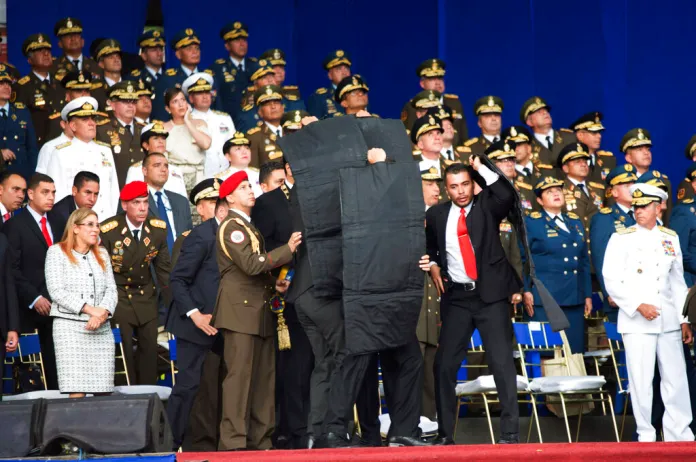Lost Authority: ISIS threat growing in Afghanistan under limited US pressure – Washington Examiner
The article “Lost Authority: ISIS threat growing in Afghanistan under limited US pressure” from the Washington Examiner examines the increasing threat of ISIS in Afghanistan following the U.S. military withdrawal in 2021. It notes that while ISIS has lost territory in Iraq and Syria, its affiliate, ISIS-K, has gained strength in Afghanistan and its surrounding regions. The Biden administration’s credibility is said to be declining, and its lack of a robust counterterrorism strategy has contributed to this resurgence.
Experts emphasize that the Taliban, although not aligned with ISIS-K, have not effectively countered its influence, creating a power vacuum filled by extremist groups. The U.S. military’s reliance on “over-the-horizon” capabilities for intelligence and strikes is deemed inadequate, resulting in a decreased ability to respond to threats. Former military officials express concern that the lack of sustained pressure on ISIS-K has enabled it to grow and plan attacks both within Afghanistan and internationally.
The article highlights the nature of contemporary terrorism as decentralized, with ISIS’s influence spreading beyond traditional strongholds. U.S. military and intelligence operations increasingly depend on partnerships with allied nations to combat these threats, as the U.S. itself struggles to conduct operations due to limited intelligence. Instances of ISIS attacks in foreign countries demonstrate the global implications of the situation in Afghanistan, and the article raises alarms about the persistent threat posed by ISIS despite U.S. efforts.
Lost Authority: ISIS threat growing in Afghanistan under limited US pressure
America’s allies believe the Biden administration’s credibility is deteriorating on the world stage and that it has lost control of escalation management in conflict zones, namely the Middle East and Ukraine. This Washington Examiner series, Lost Authority, will look at the reasons why. Read Part 1, Part 2, and Part 3.
The United States’s counterterrorism landscape has changed in the three years since the military withdrew from Afghanistan, ending its nearly two-decade war with the Taliban back in power.
While the Islamic State holds a fraction of the territory in Iraq and Syria that it controlled at its peak 10 years ago, its network of affiliates in other places, such as Afghanistan, Pakistan, and various parts of Africa, has been able to increase its capabilities, carry out external attacks, and encourage lone actors across the Western world to do the same in their own communities.
The U.S. withdrawal from Afghanistan, mired by the Abbey Gate bombing on Aug. 26, 2021, left the Taliban in charge, and while they aren’t aligned with ISIS-K, the Taliban have not consistently gone after ISIS-K, thereby allowing it to flourish.
“When we create a [power] vacuum, the forces of altruism seldom fill it. If we’re going to create a vacuum, we have to conclude that the Islamic State, the Islamic Republic of Iran, or a terrorist group like Hamas is going to fill it,” Michael Rubin, a senior fellow with the American Enterprise Institute, told the Washington Examiner. “A rhetorical commitment to maintain counterterrorism is different than a substantive commitment.”
ISIS resurgence in Afghanistan
When the U.S. withdrew from Afghanistan, defense officials said they would rely on the military’s over-the-horizon capabilities, or their capability to carry out strikes from afar without having boots on the ground to gather real-time intelligence. In the three years since, however, the U.S. has acknowledged carrying out one such operation, targeting Osama bin Laden’s successor as the leader of al Qaeda, Ayman al Zawahiri, who was killed on July 31, 2022.
Gen. Michael “Erik” Kurilla, commander of the U.S. Central Command, described Afghanistan as a “safe haven” for ISIS-K and similar groups in March. Retired Gen. Frank McKenzie, Kurilla’s predecessor, argued earlier this month on the School of War podcast that “ISIS-K flourishes now in Afghanistan,” adding, “Our ability to actually look into Afghanistan, understand what goes on in Afghanistan, is such a small percentage of what it used to be that is effectively zero.”
Despite the repeated invocations of over-the-horizon capabilities from the Pentagon, carrying out strikes and operations without having personnel in the country relaying real-time sensitive intelligence is very challenging. Retired Gen. H.R. McMaster, former President Donald Trump’s national security adviser, wrote in his new book that the over-the-horizon capabilities “approach to counterterrorism would have little effect on terrorist organizations.”
“We maintain a variety of capabilities, to include over-the-horizon capabilities, should we need to do that,” Maj. Gen. Patrick Ryder, Pentagon spokesman, said earlier this month. “But I think most importantly, we’ll continue to work with our partners in the region when it comes to addressing terrorism through our mutual counterterrorism efforts.”
Kurilla told lawmakers in March that while the Taliban have “targeted some key ISIS-Khorasan leaders in 2023,” they had demonstrated “neither the capability nor the intent to sustain adequate counterterrorism pressure,” and as a result, “this lack of sustained pressure allowed ISIS-K to regenerate and harden their networks, creating multiple redundant nodes that direct, enable, and inspire attacks. … We do not expect that dynamic to change.”
Decentralized terrorist landscape
The Pentagon maintains that even without a presence in Afghanistan, the terrorism landscape has become decentralized over the last couple of years.
“We have seen the terrorism landscape evolve over the past few years,” Lisa Lawrence, a Department of Defense spokeswoman, told the Washington Examiner. “We used to see centralized, directed external operations by terrorist leaders, including al Qaeda’s Osama Bin Laden, or the declaration of ISIS’s global caliphate. The threat today is more ideologically diffuse and geographically diverse.”
The Department of Defense has seen “the ISIS threat metastasize over the years,” Christopher Maier, the assistant secretary for special operations and low-intensity conflict, said last week. “It’s no longer in just Syria and Iraq. We’ve seen ISIS-Khorasan out of Afghanistan, but really out of that kind of broad South Asia, Central Asia region.”
Maier, in his comments last week at a Defense Writers Group event, argued that simply viewing the U.S.’s counterterrorism performance by the number of strikes it has conducted in Afghanistan over the last three years is “a little bit too simplistic.”
However, McKenzie said in March, “We have almost no ability to see into that country and almost no ability to strike into that country. And so, ISIS is able to grow unabated. There’s no pressure on them.”
He added: “It began to grow as soon as [the U.S.] left Afghanistan, took pressure off ISIS-K. So I think we should expect further attempts of this nature against the United States as well as our partners and other nations abroad. I think this is inevitable.”
US facilitates partners
Maier echoed Lawrence’s sentiment that the U.S. strategy is now “much more relying on our partners and allies to help us and work with us to identify where these threat vectors may be and disrupt them,” noting that U.S. partners are often making the arrests now.
“Often it is not the United States doing the arrests — it’s us facilitating partners. The scope has gotten bigger, to the point where we’re already answering the question on Europe,” he said. “Often it’s Europeans or others that are the ones who are on point of conducting arrests, disruptions, and such.”
ISIS-K has carried out attacks this year outside of Afghanistan and inspired others, though the U.S. intelligence community has been able to uncover the plots before they happened. The U.S. government has a “duty to warn” policy that requires it to inform another country of threats to specific people or groups, which is why in those cases the U.S. has reached out to the relevant foreign counterparts to inform them of the intelligence.
ISIS-K carried out a bombing in early January in Iran near the burial site of the slain Soleimani that killed more than 80 people and injured more than 280 others, while in March, ISIS gunmen opened fire with automatic weapons at a crowded concert venue on the outskirts of Moscow, Russia, killing at least 137 people and injuring more.
In both cases, the U.S. had intelligence to indicate a terrorist attack could occur and passed it along to its partners in Tehran and Moscow, respectively, but neither was able to thwart the attacks from taking place.
“One thing I would highlight is U.S. intelligence seems to be remarkably aware of some of the plots. It warned the Russians and warned the Iranians,” Daniel Byman, a senior fellow with the Center for Strategic and International Studies, told the Washington Examiner.
Multiple teenagers radicalized by ISIS were arrested earlier in August for plotting to target a Taylor Swift concert by Austrian authorities, who were tipped off by the CIA.
“The Austrians were able to make those arrests because the agency and our partners in the intelligence community provided them information about what this ISIS-connected group was planning to do,” CIA Deputy Director David Cohen said Wednesday at the Intelligence and National Security Summit.
Cohen said the alleged perpetrators intended “to kill a huge number of people, tens of thousands at this concert, including, I’m sure, many Americans.”
Maier noted that the department has benefitted from some Central Asian countries “becoming more attuned to the threat from Afghanistan,” though he did not provide specific details about which nations they are working alongside.
ISIS is also expected to double its number of attacks carried out this year compared to last, CENTCOM announced last month. The U.S. and allies involved in the “Defeat ISIS” campaign have carried out 196 operations this year as of that announcement, which resulted in the deaths of 44 ISIS operatives and the apprehension of 166 others. About 70% of the missions took place in Iraq. Experts believe the number could be even higher.
Earlier this month, U.S. forces targeted and killed Abu-’Abd al Rahman al Makki, senior leader of the al Qaeda affiliate Hurras al Din, in Syria, which Lawrence said demonstrated the military’s preservation of its “ability to conduct unilateral [counterterrorism] operations,” though the U.S. has forces in Syria making it easier to carry out such targeted strikes.
The Pentagon and its Iraqi counterparts are in discussions to transition the military mission there, though the outcome is not clear. There are roughly 2,500 U.S. troops in Iraq and about 900 in Syria, and their mission is to prevent an ISIS resurgence.
Kurilla warned lawmakers that if U.S. forces left Iraq before its partner forces were independently sufficient, his assessment is that ISIS “would reconstitute the ability to seize territory within two years.”
A major factor in defeating ISIS in Iraq and Syria is the repatriation and reintegration of displaced people from refugee camps such as al Hol and the repatriation and prosecution of ISIS detainees held in prisons in Syria. There are roughly 43,000 men, women, and children in the al Hol camp in Syria, one of the largest such camps.
Kurilla has continued to stress that getting these civilians repatriated could prevent a new generation from getting radicalized.
" Conservative News Daily does not always share or support the views and opinions expressed here; they are just those of the writer."




